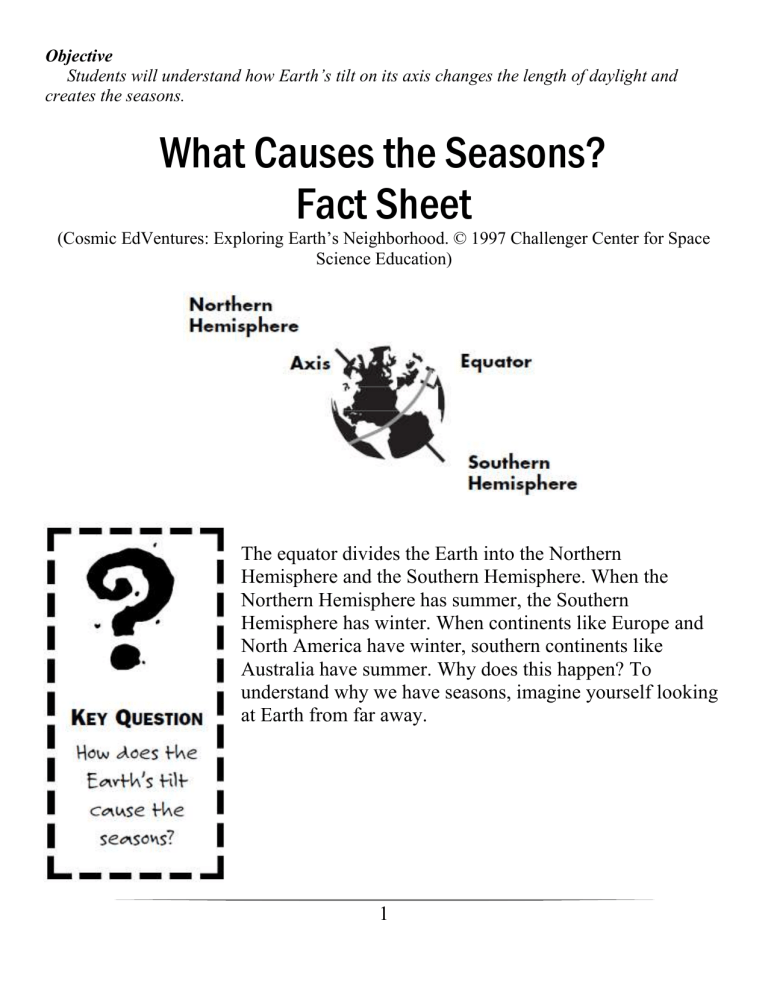A New Slant on the Seasons

Objective
Students will understand how Earth’s tilt on its axis changes the length of daylight and creates the seasons.
What Causes the Seasons?
Fact Sheet
(Cosmic EdVentures: Exploring Earth’s Neighborhood. © 1997 Challenger Center for Space
Science Education)
The equator divides the Earth into the Northern
Hemisphere and the Southern Hemisphere. When the
Northern Hemisphere has summer, the Southern
Hemisphere has winter. When continents like Europe and
North America have winter, southern continents like
Australia have summer. Why does this happen? To understand why we have seasons, imagine yourself looking at Earth from far away.
1
Objective
Students will understand how Earth’s tilt on its axis changes the length of daylight and creates the seasons.
Each year, the Earth makes one trip, or orbit, around the Sun. When looking down on the North Pole, the Earth orbits counterclockwise around the Sun. The Earth’s axis is the imaginary line that runs through the Earth from the North Pole to the
South Pole. The Earth’s axis is tilted 23.5°. This means that as the Earth travels around the Sun, different parts of the Earth will end up being tilted toward the Sun.
In December, the Southern Hemisphere tilts toward the Sun. In June, the Northern
Hemisphere tilts toward the Sun.
Our Pole Star
If you could extend the Earth’s axis into space, the northern end would point toward a star called
Polaris (poh-LARE-iss). Polaris means “the pole star.” People sometimes call Polaris “The North
Star.” You can find Polaris at night in the Northern
Hemisphere by using the Big Dipper.
Summer Sunlight: Direct & Intense
Being tilted toward the Sun does not make you much closer to the Sun. The reason a tilt toward the Sun causes warmer weather is due to more intense sunlight. When your hemisphere tilts toward the Sun, the rays of sunlight hit the hemisphere more directly. The energy from the sunlight is intense, warming the ground more. In winter, the Sun’s rays hit the ground at a greater angle, spreading the sunlight’s energy over a larger area.
2
Objective
Students will understand how Earth’s tilt on its axis changes the length of daylight and creates the seasons.
Another Cause of Seasons
The tilt of the Earth also has an effect on the length of daylight. When you are tilted toward the Sun in the summer, the Sun rises higher overhead at noon. Days are longer with shorter nights. Longer days mean more hours the sunlight can heat the ground. In the winter, the Sun is not as high in the sky at noon. It rises later and sets earlier. Shorter days mean less time that the Sun’s energy can warm the ground, leading to cooler temperatures.
The Land of the Midnight Sun
The changing amount of daylight is extreme in the most northern and southern latitudes. In June, the Northern Hemisphere tilts enough toward the Sun that sunlight can reach all the land north of the Arctic Circle at the same time. As the
Earth rotates, the Sun circles the dome of the sky, but never sets. Sometimes the lands far to the north are called “the Land of the Midnight Sun” because during the summer, the Sun will be shining even at midnight. While the Sun is shining at midnight in northern Alaska, Antarctica has a long, dark winter. With the
Southern Hemisphere tilted away from the Sun, most of Antarctica does not get any sunlight in June. Instead, Antarctica has 24 hours of darkness.
Bet Your Family an Ice Cream Sundae!
Bet your family a chocolate sundae with all the trimmings that they do not know the reasons for the seasons and see what happens!
3
Objective
Students will understand how Earth’s tilt on its axis changes the length of daylight and creates the seasons.
Many people believe the whole planet is closer to the Sun in the summer than in the winter. If that were true, every place on Earth would have winter during the same months!
We know the Southern Hemisphere has winter while the
Northern Hemisphere has summer. The distance between the
Earth and the Sun does change because the Earth’s orbit is not perfectly round, but it cannot cause the seasons we observe. Research shows us that the Earth is actually closest to the Sun around January 3 each year—almost the coldest time of year for most of the Northern Hemisphere.
4
Objective
Students will understand how Earth’s tilt on its axis changes the length of daylight and creates the seasons.
Name ___________________________________________________________
A New Slant on the Seasons
Worksheet
YOUR MISSION
King Caeson and his family have some questions. Is December a good time of year to vacation in Australia? What clothes should they pack?
As Royal Court advisors, study models of the Sun and Earth to figure out the reasons for the seasons and give King Caeson advice about his vacation plans.
1. Label each month, based on the Earth’s position:
Warming the Earth
5
Objective
Students will understand how Earth’s tilt on its axis changes the length of daylight and creates the seasons.
2. Observe the shape and size of the grid boxes for June and December in the
Northern Hemisphere and the Southern Hemisphere. Write two observations comparing the grid’s boxes.
June December
Northern
Hemisphere
Southern
Hemisphere
1.
2.
1.
2.
1.
2.
1.
2.
3. Which hemisphere gets the most energy from sunlight in…
June?__________________________________________________________
December? _____________________________________________________
4. Based on your answers for question 3, where do you think it is usually warmer in
December? (circle one)
United States Australia
It is not warm in either place during December.
6
Objective
Students will understand how Earth’s tilt on its axis changes the length of daylight and creates the seasons.
Northern Hemisphere
June
December
Southern Hemisphere
June
7
Objective
Students will understand how Earth’s tilt on its axis changes the length of daylight and creates the seasons.
Southern Hemisphere
December
8









